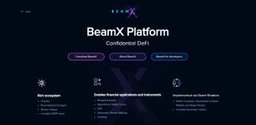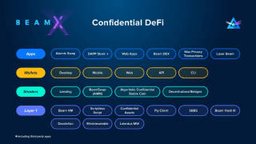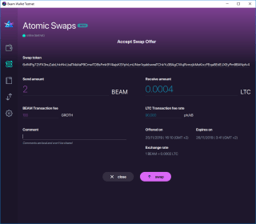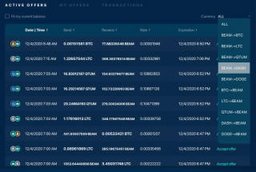BeamX

BeamX
BeamX (launched November 2020) is a confidential DeFi (Decentralized Finance) protocol created by developers of scalable and confidential privacy cryptocurrency, Beam. The BeamX platform will enable creating decentralized financial applications like DEX, Automated Market Makers, Stablecoins, NFTs etc. that are confidential, decentralized and user-friendly.[1][33]
Company
| Notable People | Role |
|---|---|
Alexander Zaidelson | CEO & Business Lead |
| Alex Romanov | CTO & Tech Lead |
Amir Aaronson | COO |
Beni Issembert | CMO |
Fundrasing
Overview

What is BeamX?
The BeamX protocol is a major development in Beam project and it will enable creating digital assets, financial applications (like DEX, Lending platforms, AMM, NFTs etc.) that are confidential, decentralized and user-friendly just like Beam to be developed on top of the Beam Platform. This is collectively known as confidential DeFi. The experimental Testnet was introduced on November 19,2020 and mainnet will be launched in Q1, 2021 after a fork and it will continue development throughout 2021.[4]
Technology
The BeamX platform has many components that form the required infrastructure for the ecosystem similar to DeFi ecosystem developed on the Ethereum network.
The basic difference is Beam is a UTXO based confidential cryptocurrency based on the hybrid MimbleWimble + LelantusMW protocol while Ethereum uses Account Based model. Some of these major components in BeamX protocol are.
Beam Confidential Assets
Beam enabled the creation of new types of tokens called Confidential Assets (CAs) with the release of eager-electron 5.0 in May 2020.
[5] These assets possess all the properties of the original Beam Coin ( namely confidentiality and scalability, etc) and are handled by Beam wallets.
These assets can be of any type, including Stablecoins like Dai. Anyone can now create a new asset type by locking 3000 BEAM coins. The creator is called as 'asset owner' and he/she can then emit or burn any amount of the newly created asset that belongs to that owner. This transaction or event will be openly visible on the blockchain and reflected in the Blockchain Explorer.[6]
If the owner controls all of the emitted asset, he/she can get back the locked deposit by burning all of the created asset and unregistering the asset type.
If some amount of the new CA was transferred to other users, it can no longer be burned and unregistered for many obvious reasons.
The main difference compared to Ethereum tokens (ERC20 s) is that only the total supply of a CA can be seen on the blockchain, but individual transactions and holdings are fully confidential and these CA assets are implemented on Layer 1 and are native citizens of Beam ecosystem.[22][23][27]
Each Beam transaction can simultaneously include any number of different CA types both as inputs and as outputs, provided all inputs and outputs of the same CA type sum to zero.[7]
Oracles
Blockchain Oracles are third-party services that provide smart contracts with external information like price feeds, etc. These bridges play an essential role in connecting blockchain applications to real-world events and financial data. These Oracles are always either centralized or federated and currently no truly decentralized oracle architecture exists. Oracles serve as final arbiters on the contract settlements. BeamX relies on third party oracles to get prices and market data to the Beam ecosystem.
Transaction Kernels
These are the kernels that remain on the blockchain forever and these are essential for validation of the protocol.
As Beam is a privacy coin, each beam transaction consists of a set of inputs and outputs represented by Pedersen commitment with adjacent Zero-knowledge proof range. Additionally, each transaction contains transaction Kernels, which originally contain the signed difference between the blinding factors. These kernels were extended to support several different purposes, such as reflecting transaction type, supporting Lelantus shielded pool and also enable running smart contracts on a Beam blockchain. TKs are capable of specifying side effects i.e. explicit change of the node state. These changes can include transformations on inputs and outputs so these operations effectively transform Beam into a hybrid UTXO based <> State Based cryptocurrency and allow smart contracts to operate.
Beam Shaders
The BeamX platform will power the developers to create DApps and financial instruments by using Ethereum-like Smart contract and user-friendly frontend components. The smart contracts are called Beam Shaders and those will be compiled from a variety of programming languages into WebAssembly (WASM) and will be executed by the Beam Virtual machine (BVM) running on Beam nodes. Using WASM enables creators of smart contracts to use a wide variety of programming languages such as Rust, Go, C++ etc. Beam Shaders specify the implementation of smart contracts on the Beam blockchain.
The Shaders have two sides side namely, Chain Side Beam Shaders and Wallet side Shaders.
Chain side shaders are deployed on the blockchain and used for the implementation of smart contract logic and Wallet side Shaders implementing the client-side logic for creating transactions necessary to interact with the Chain side Shaders.[7]
| Sr.no | Chain side Shaders | Wallet side Shaders |
|---|---|---|
| 1 | Deployed on the Blockchain side | Deployed on client-side (Wallets) |
| 2 | These can only be invoked by transactions. | These Shaders encapsulate client logic and the API required to interact with each specific contract and they can be implemented either by the creators of the contract or by third parties. |
| 3 | These Shaders can collect fees, can call other Shaders, ability to perform emission ad burning of Confidential Assets, Lock and Unlock Funds and Overdraft protection (validating amount of locked and unlocked funds to prevent creating coins out of thin air). | These provide maximum flexibility for separation of client and chain side logic and allows creating complicated Wallet Applications by creating a single UI for a group of different Chain side Shaders, including creating complex flows that perform operations across multiple different applications. |
| 4 | These are executed within Nodes and Applications. | These are executed in Desktop and mobile wallets. |
Scriptless Contracts
In the current model of DeFi ecosystems, the smart contracts are executed by the virtual machine built into each node and the blockchains implementing these smart contracts usually use account based models (e.g. Ethereum) and not UTXO (e.g. Bitcoin or Beam).
The Beam blockchain is based on MimbleWimble technology and it will allow developers to build ‘Scriptless Contracts’ that would both allow transition between UTXO and Account model, and implement complex business logic. This is possible because the implementation of the transaction kernels, which are key enablers of the Mimblewimble extensibility. Just as in Lelantus, the kernels enable the transformation of UTXOs into system state and vice versa thus allowing contracts to operate.
When the user creates CA, the transaction takes place off-chain and is performed via exchange of SBBS (secure bulletin board system) message between the wallets and creation of new types of transactions.
So the trade itself is formed off-chain in the form of a multisig agreement, but the settlement and verification are done on-chain, thus making sure the eventual state of the system is always consistent. The resulting architecture, thus utilizes all of the Beam infrastructure, including Atomic swaps for locking non-Beam collateral, Laser Beam channels for instant payments where required, SBBS for all off-chain negotiations and ‘Scriptless Contracts’ to handle the application logic.
Sidechains
The BeamX platform makes possible to launch a sidechain with a different consensus mechanism such as GhostDAG or Proof-of-stake. Despite being a separate blockchain, the side chains are designed to maintain two side peg to Beam at all times, making it possible to reliably move value from Beam Mainnet to Side chain and back. It also enables developers to create smart contracts. These changes can help sidechains to grow its own ecosystem. The users can also move assets seamlessly from Beam to the sidechain and back again using Beam chain interoperability contracts.
If a sidechain does not have a native token, any CA or Beam coin itself, can be locked on the original Beam blockchain and then can be reissued on the sidechain for the same owner.
The moving back procedure works is the same as creating CA asset, and original Beam coins on mainnent will be un-locked by burning reissued asset on the sidechain.
It helps to achieve seamless trades between Beam blockhain and the sidechain.
If a sidechain has its own token, this token can not be moved to Beam blockchain and it can only be used within the side chain .
But the assets from the main chain can still be moved and traded on the sidechain against either other assets or sidechain's native token.
Since both blockchains are based on the Mimblewimble protocol, the trading will be seamless and inherits the same properties of confidentiality and scalability as the Beam blockchain.[6]
Bridges
Bridge mechanisms will allow users to lock coins on foreign chains such as Bitcoin or Ethereum, and receiving their equivalent representation in Beam CA assets. These bridges provide blockchain interoperability solutions and help to bring more liquidity to the DeFi protocols. These bridges can be either centralized or federated, with some trust minimization in case the original chain supports smart contracts.
Roadmap & Development
Beamx development started with the release of Eager Electron 5.0 in June 2020.
All the confidential DeFi development is spanned between two major releases Eager Electron 5.0, and Fierce Fermion 6.0.
The the next major version that will require a hard fork to introduce new capabilities into the Beam node.
The versions 5.1 and 5.2 contain Beam contracts POC (Proof of concept), Beam script POC and Beam <>ETH decentralized bridge POC.[8]
Testnet
The version 5.3 is BeamX testnet and it is launched on November 19, 2020.
This release contains Beam contracts on testnet, Beam <>ETH decentralized bridge on testnet and Beam Sidechains POC.
Anyone can be part of Testnet and need to follow the steps mentioned here to get involved.[9]
| Steps | Description | Links |
|---|---|---|
| 1 | You need to get either DesktopGUIorCLI wallet to get started.Desktop GUI wallet is available forMS WindowsandMaconly.Cli wallet is available for Windows, Mac andLinux.If you go for Cli wallet, you will also need to setup BeamX node and install shaders. | [10][9] |
| 2 | Once wallet is ready, you will need Beam testnet coins which you can either get from the Faucet contract or ask for it from admins in BeamX support group on theTelegram. | [11][12] |
| 3 | When you receive these coins you can use it to test applications by putting in Vaults, playing Roulette.etc | [13][14] |
| 4 | You can also create Confidential Assets on the Testnet. | [32] |
| Note | These testnet Beam coins are only for experimental/test purpose and have no value nonce mainnent goes live. |
This iteration is to straighten out any bugs and updates needed in development, infrastructure, documentation, and the developer tool suite.
The launch coincides with Encode Hack Club hackathon, a 10-week blockchain hackathon aimed at universities and hackers.
It is started on November 9, 2020.
The Beam will be competing against top crypto firms, including Binance, Polkadot, and Avalanche. [16]
Mainnet
The Mainent activation will require a hard fork to introduce new capabilities into the Beam node and it is expected to go live in Q1, 2021.
The creation of Confidential Asset is live though, and you can get involved if you feel interested.[26] Please note that You will need 3000 BEAMS, which will be locked, to enable the creation of the Confidential Asset and To retrieve these 3000 Beam, you will need to burn the entire number of the CA asset your created.
When you intend to distribute your own CA, you will not be able to retrieve these locked BEAMS without personally owning every single CA amount that you have issued.
You can also try creating CA on testnet before trying this.
Chainlink Integration
In a recent development, Beam announced that it has planned integration with Chainlink’s market-leading oracle network to securely and reliably deliver external asset prices and market data to the Beam ecosystem. The Beam will leverage the Chainlink Price Feed framework to launch decentralized price oracles for BEAM/USD and BEAM/ETH. In particular, these Price Feeds will support Beam’s confidential stablecoin protocol, as well as its Beam-Ethereum ERC-20 bridge for moving assets between the Ethereum and BeamX blockchains.[17]
Types of DeFi Applications
Generally these DeFi Apps are categorized as Lending, Synthetics and Decentralized Exchanges.
DeFi apps will work in similar way compared to Ethereum ecosystem but major difference assets created on BeamX will have same properties such privacy and scalablity etc. like Beam coin.
The BeamX platform will enable creating financial applications that include DEX, Uniswap-like Automated Market Maker, Dai-like Algorithmic Stablecoins, lending, wrapped assets (e.g.,Wrapped Bitcoin (WBTC)) and Non-Fungible Token (NFT) tokens. [6]
Lending
As CA will inherit same properties like Beam Coin, Assets in the Wallet or Wallet balance of a holder will not be visible on the blockchain as compared Ethereum or ERC20 token which are visible to anyone.
So, lending transactions will be visible on the blockchain but balances will remain hidden.
Synthetix
Synthetix are representation of real world assets.
It includes both fungible (stocks, commodities) and Non-Fungible assets (real estate etc). On the Beam chain, each asset is represented by a matching Confidential Asset type(CA) and their relation to the real-world assets is handled using the Oracles.
Decentralized Exchange
Beamx will have Atomic Swaps and Pertual swaps both.
So users will be able to trade using futures, options, long and short trading and a multitude of other financial instruments including many variations of derivatives.
Beam atomic swap is already developed in 2019 and it is available in the desktop wallet supporting swap between BTC, LTC, Qtum and Beam. DASH and Dogecoin are added to Atomic Swap recently. ETH and DAI support are in the development process.[29] Perpetual Swaps is the one BeamX developers are considering to develop first in DeFi roadmap. The application will utilize SBBS for creating contracts and Laser Beam payment channels for locking collateral, handling funding transactions and settlement. [8]








